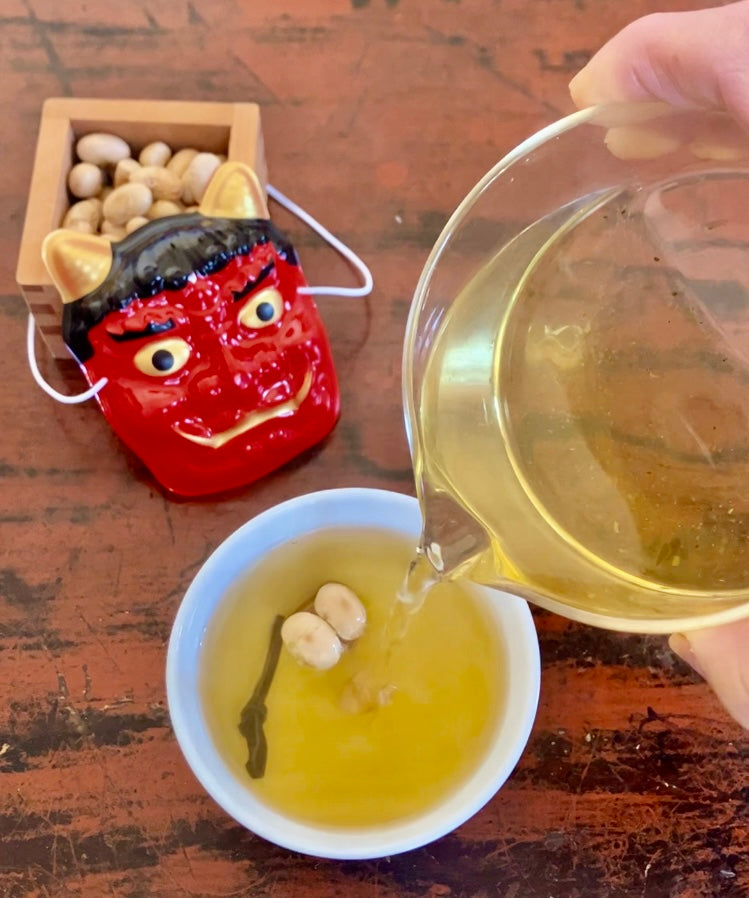節分は、日本の太陰暦で春の始まりの前日である2月2日、3日、または4日に行われる日本の伝統的な祭りです。節分という言葉は、文字通り2つの季節(冬と春)の分割を意味し、太陰暦によると、節分は冬の季節の終わりと春の到来、特に立春と呼ばれます。節分の暦上の日付は立春に依存しており、立春も同様に太陰暦に依存し、2月2日から4日の間に行われます。興味深いことに、節分は過去30年間2月3日でしたが、2021年は2月2日でした。今年(2024年)の節分は2月3日です。
節分の起源は古代中国にあると言われています。史料によると、このお祭りは平安時代(794-1185)に日本に伝わったようです。厳密には国民の祝日ではありませんが、日本人は何世紀にもわたり、春の初めに邪気を払うための儀式を行ってきました。例えば、13世紀には、干したイワシの頭を焼く強い匂い、燃える木の煙、太鼓の音で邪気を追い払う習慣が生まれたと言われています。現在ではこうした習慣は行われていませんが、邪気を家の中に侵入させないために、魚の頭やヒイラギの葉を家の入り口に飾る人もいます。実は先日、スーパーで「ヒラギ」というオリーブ科の植物を見つけました。正確に言うと、それはただのキンモクセイではなく、キンモクセイの棘と豆の殻の音、そしてイワシの匂いで邪気を払うという説明書きが書かれた節分のお札でした。なんと鬼のお面までついていました!
 節分が近づくとスーパーなどで見かける節分関連商品。左:節分セットに入っている「ひらぎ」。右:節分の豆まき用の大豆。
節分が近づくとスーパーなどで見かける節分関連商品。左:節分セットに入っている「ひらぎ」。右:節分の豆まき用の大豆。
室町時代(1336-1573)に、災いをもたらす悪霊である鬼を追い払うために豆をまくことが始まりました。豆まきは今でも節分の最大の目玉の一つで、私も子供の頃の楽しい思い出があります。「なぜ豆なの?」と不思議に思うかもしれません。豆は生きていくために欠かせない主食でした。そして米と共に、豆には邪気を払う神聖な力があると信じられていました。特に、豆は日本語で「豆」であり、 「魔目」と発音が似ています。さらに、豆をまくことは鬼を滅ぼす(魔滅)ことに似た意味合いがあります。
節分祭の見どころ
豆まき:家の周りで煎った大豆をまき、節分の日にだけ行われる最も一般的な風習でしょう。豆をまきながら、 「鬼は外、福は内! 」と唱え、家中に豆をまいたり、鬼に向かって投げたりします。これは「鬼は外、福は内!」と訳されます。豆まきは、玄関から一番遠い部屋から始めるのが良いでしょう。また、豆をまきながら窓を開けておくと、邪気が簡単に逃げられると言われています。特に小さなお子様がいるご家庭では、鬼に扮した家族に豆を投げるという楽しい風習もあります。面白そうに聞こえますが、私は鬼にはなりたくないですね。多くの人は、自分の年齢と同じ数の煎った豆を食べます。これは幸運をもたらすと言われているからです。子供の頃、自分の年齢よりもっと豆が食べたいと思ったことをかすかに覚えています(豆は美味しいと思っていたので!)。節分の時期に日本を訪れる機会があれば、多くの神社や寺院で豆まきが行われ、神職や奉納者が豆やお金、その他の景品を参拝者に投げる様子を目にすることを覚えておいてください。節分の行事であることを意識している方なら、特に見ていて楽しいイベントになるでしょう。
恵方巻:「恵方巻き」は、節分の日にだけ食べられるユニークなタイプの寿司ロールです。幸運の寿司ロールと考えることができます。「恵方」は、その年の幸運を司る神様である歳徳神のいる方向を指します。恵方巻きは、レストランで見かける典型的な寿司ロールに比べて、比較的長く、多くの具材(大きい)があります。一般的に、恵方巻きには、7という数字が幸運に関連付けられているため、キュウリや卵を含む7つの具材を使用するのが良いとされています(一般的な具材とその意味については以下を参照)。これは、日本に七福神と呼ばれる有名な幸運の神がいることにも由来しています。

 上の写真は、近所で有名な七福神です。よく見ると、それぞれの神様の特徴が分かります。それぞれ異なる徳と意味を象徴しています。
上の写真は、近所で有名な七福神です。よく見ると、それぞれの神様の特徴が分かります。それぞれ異なる徳と意味を象徴しています。
もう一つ注意すべき点は、恵方巻きを食べる時は、その年の幸運をもたらすとされる方角を向く必要があるということです。方角は毎年変わるので、事前に確認しておきましょう!今年の恵方巻きは東北東です。また、恵方巻きは大きめですが、縁を切ったり、幸運を逃したりしないよう、包丁で切らずに丸ごと食べるのが良いとされています。私は恵方巻きをゆっくりと少しずつ食べるのが好きですが、中には一気に食べてしまう人もいます。これは、食べながら願い事をするのが大切だからかもしれません。話したり、集中力を切らしたりすると幸運が消えてしまうので、恵方巻きを食べている間は話をしない方が良いと言われています。また、目を閉じて食べたり、笑いながら食べたりするのも良いと言われています。地域によって多少の違いはありますが、恵方巻きには特別な食べ方があるようです!恵方巻きは、遠くまで行かなくても簡単に見つかります。最近では、セブンイレブン、ファミリーマート、ローソンといった代表的なコンビニエンスストアをはじめ、大手寿司チェーン店やスーパーマーケットでも毎年恵方巻きの提供に力を入れており、中にはスイーツとして恵方巻きや恵方ロールを開発しているところもあります。

昨年(2023年)の節分の恵方巻きの写真です。実は、京都の鴨川の方角を向いていたので、恵方巻きの向きを忘れていたかもしれません。2024年の節分では、恵方巻きは東北東、特に東北東微東だと言われています。
恵方巻きの主な材料
- かんぴょう:細くて長いので長寿や縁結びを祈願する。
- 椎茸の煮物:椎茸の傘の形が陣笠に似ていることから、身を守るという意味がある
- 卵(日本語:玉子焼き/伊達巻き):金色は「金運アップ」を意味し、伊達巻きは巻物に似ていることから「知識向上」に繋がります。
- ウナギ:遡上するウナギ - 「昇進、上昇」
- キュウリ:日本語ではキュウリを「キュウリ」といい、「九の利を得る」という意味が込められています。
- エビ:背中が曲がるまで長生きすることを表します(ただし、背中が曲がらないことを祈ります!)
- 桜でんぶ:鯛などの白身魚を使ったおでんぶ。桜色は春を象徴し、縁起が良いとされています。
幸運茶
福茶:最後に、縁起の良いお茶「福茶」を飲む習慣があります。福茶の特徴は、海藻、梅干し、そして豆まき用の豆を3つ入れることです。元旦に福茶(新年を迎えるためのお茶なので、 以前は「お福茶」と呼んでいました)を飲む地域もありますが、西洋占星術以前の伝統的な暦では、節分に飲むお茶です。一年の健康を祈りながら、ぜひお楽しみください!

福茶の材料
- 塩昆布(または昆布の佃煮) 1~2枚。上の写真はむすび昆布です。 結び昆布は、結び目を作ることで喜びを結びつけ、家族の絆を強めるという意味があるため、福茶に使うのに適した昆布なのかもしれません。
- 梅干し1個
- 豆(豆まき用の豆)3粒。豆を焙煎することで、お茶に良い風味が加わります。3粒にこだわる人もいますが、多すぎても少なすぎてもいけません。豆はお茶と一緒に食べられるので、覚えておいてくださいね!
- お湯またはお茶 適量。お茶は緑茶である必要はありません。玄米茶、ほうじ茶、番茶などお好みのお茶でも美味しくいただけます。
麹由来の福茶
麹(コウジ)は、醤油、味噌、日本酒の原料となる特殊なカビです。ふく茶(上記の材料を入れたお茶)に、沸騰したてのお湯、または淹れたてのお茶を注ぎ、少し冷ましてから、ひとつまみの麹を加えてゆっくりと飲むのがおすすめです。生の麹を使うのが最適ですが、乾燥麹でも構いません。
 麹について詳しくは幸子さんの記事をご覧ください。写真は村田幸子さん。
麹について詳しくは幸子さんの記事をご覧ください。写真は村田幸子さん。
福茶のベースとして珍しい日本の番茶を試してみる
最近は、香ばしい京番茶や、徳島県産の弱発酵の阿波番茶など、様々な地域の番茶を楽しんでいます。開運茶のベースは、必ずしも煎茶である必要はありません。海苔の塩味、梅、そして豆の風味と相性の良いものを、ぜひいろいろと試してみてください。
今年の2月の節分に日本にいらっしゃる方は、豆まきや恵方巻きと一緒に福茶もぜひお楽しみください。海外にお住まいの方も、ぜひご自身で(即席で)福茶を作ってみてください。健康と幸運を祈って乾杯!
注目画像:節分の福茶「福茶」を淹れる様子。写真のベースとなるお茶は、徳島県上勝町産の阿波晩茶を、美智子さんが手摘みで天日干ししたもの。
何か他にご意見やご質問がございましたら、お気軽に下記にコメントやご質問を投稿してください。または、私(Moé Kishida)まで直接ご連絡ください(moe@yunomi.life)。よろしくお願いいたします。


